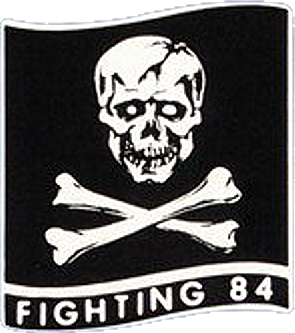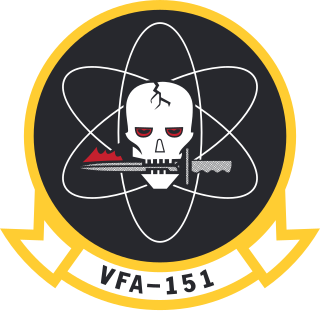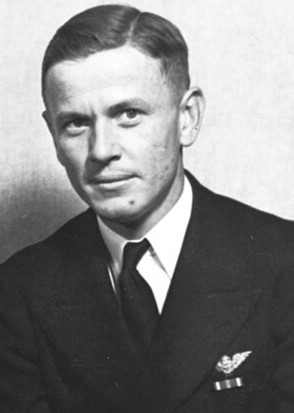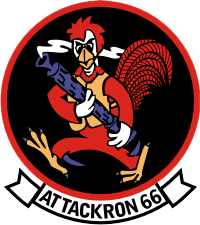
VF-84, Fighter Squadron 84 was an aviation unit of the United States Navy. Originally established as VA-86 on 1 July 1955, it was immediately redesignated as VF-84 and was disestablished on 1 October 1995. It was the third US Navy squadron to be designated as VF-84. The squadron was nicknamed the Jolly Rogers and was based at NAS Oceana. It took the number but not the lineage of VF-84 the "Wolf Gang" and the insignia of VF-61 the Jolly Rogers.

Strike Fighter Squadron 103 (VFA-103), nicknamed the Jolly Rogers, is an aviation unit of the United States Navy established in 1952. VFA-103 flies the F/A-18F Super Hornet and is based at Naval Air Station Oceana, Virginia (US). The squadron's radio callsign is Victory and it is assigned to Carrier Air Wing Seven.

Strike Fighter Squadron One Five One (VFA-151) nicknamed the Vigilantes are a United States Navy F/A-18E Super Hornet fighter squadron stationed at Naval Air Station Lemoore, California. The squadron is a part of Carrier Air Wing 9 (CVW-9). As part of CVW-9, the squadron's tail code is NG and its radio callsign is "Ugly".

Strike Fighter Squadron 11 (VFA-11) is a United States Navy strike fighter squadron stationed at Naval Air Station Oceana, Virginia, United States. The squadron was established in 1950 and is nicknamed "Red Rippers". VFA-11 is equipped with the Boeing F/A-18F Super Hornet and currently assigned to Carrier Air Wing One.

VF-74, Fighter Squadron 74, Be-Devilers was an aviation unit of the United States Navy in service from 1944 to 1994. Originally established as VBF-20 on 16 April 1945, it was redesignated as VF-10A on 15 November 1946, redesignated as VF-92 on 12 August 1948, redesignated as VF-74 on 15 January 1950 and disestablished on 30 April 1994. It was the third US Navy squadron to be designated as VF-74.

Fighter Squadron 111 (VF-111), also known as the Sundowners, was a fighter squadron of the United States Navy. Originally established as Fighter Squadron 11 (VF-11) on 10 October 1942, it was redesignated as VF-11A on 15 November 1946, redesignated as VF-111 on 15 July 1948 and disestablished on 19 January 1959. On 20 January, another squadron, VF-111 (1956-95) then assumed the designation until its de-establishment in 1995. In November 2006, VFC-13 Detachment Key West was redesignated as VFC-111, taking on the Sundowner insignia and callsign.

Fighter Squadron 143 or VF-143 was an aviation unit of the United States Navy originally established as a Naval Reserve squadron VF-821 on 20 July 1950 it was redesignated VF-143 on 4 February 1953 and disestablished on 1 April 1958.

John Thomas Blackburn was an American naval aviator, World War II flying ace, and the first commanding officer of the famed F4U Corsair squadron VF-17 Jolly Rogers.

VF-121 of the US Navy was a former Pacific Fleet Replacement Air Group (RAG) unit. Originally established on 1 July 1946, as VF-781, it was redesignated as VF-121 on 4 February 1953 and disestablished on 30 September 1980. On 11 April 1958 it changed duty from Fleet Squadron to Fleet Replacement Squadron and was later charged with the training of Navy F-4 Phantom flight and maintenance crews.

All Weather Fighter Squadron 3 was a designation which was used by two separate U.S. Navy aviation squadrons. The first squadron to use the designation was established as Composite Squadron THREE (VC-3) on 20 May 1943, was redesignated All Weather Fighter Squadron THREE on 1 July 1956 and was disestablished on 2 May 1958. The second squadron to use the designation was established as "Navy Air Training Unit-Pacific (NATUPAC)" on 22 May 1944, was redesignated "Night Development Squadron Pacific (NightDevRonPac)" on 6 April 1946, then "Fighter All Weather Training Unit Pacific (FAWTUPAC)" on 1 September 1948 and finally, on the same day as the first squadron designated VF(AW)-3 was disestablished, 2 May 1958, was redesignated "All Weather Fighter Squadron THREE (VF ". This second squadron to carry the VF -3 designation adopted the insignia and nickname "Blue Nemesis" from the first VF -3 and was the only U.S. Navy unit to be assigned to the North American Air Defense Command.

Attack Squadron 54 (VA-54) was an attack squadron of the U.S. Navy. Originally established as Bomber Fighter Squadron VBF-153 on 26 March 1945, redesignated Fighter Squadron VF-61A (VF-16A) on 15 November 1946, redesignated VF-152 on 15 July 1948, and VF-54 on 15 February 1950. It was finally redesignated VA-54 on 15 June 1956. The squadron was disestablished on 1 April 1958. It was the second squadron to be designated VA-54, the first VA-54 was disestablished on 1 December 1949.

VA-66 was an Attack Squadron of the U.S. Navy; it was the second squadron to be so named. The squadron was called to duty and established as Reserve Fighter Squadron VF-671 on 1 February 1951. It was redesignated Fighter Squadron VF-81 on 4 February 1953, and finally as VA-66 on 1 July 1955. The squadron was disestablished on 1 October 1986, but one detachment continued in existence until 31 March 1987. The squadron's nickname was the Waldomen from the 1950s to the early 1960s, and the Waldos from that point forward. Its insignia, a rooster toting a machine gun, was a well-known design in naval aviation.

VA-34, nicknamed the Blue Blasters, was an Attack Squadron of the U.S. Navy. The squadron was established as Fighter Squadron VF-20 on 15 October 1943, redesignated as VF-9A on 15 November 1946, as VF-91 on 12 August 1948, and as VF-34 on 15 February 1950. It was finally redesignated VA-34 on 1 July 1955. The squadron was disestablished on 1 June 1969. It was the second squadron to bear the VA-34 designation, the first one having been renamed VA-35 in 1950.

VA-44, nicknamed the Hornets, was an Attack Squadron of the US Navy. The squadron was established as Fighter Squadron VF-44 on 1 September 1950, and redesignated VA-44 on 1 January 1956. It was disestablished on 1 May 1970. It was the second squadron to be designated VA-44, the first VA-44 was disestablished on 8 June 1950.

Fighter Squadron 52 or VF-52 was an aviation unit of the United States Navy. Originally established as Bombing Fighting Squadron 5 (VBF-5) on 8 May 1945, it was redesignated Fighting Squadron 6A (VF-6A) on 15 November 1946, redesignated as Fighter Squadron 52 (VF-52) on 16 August 1948 it was disestablished on 23 February 1959. It was the third US Navy squadron to be designated as VF-52.
Fighter Squadron 122 or VF-122 was an aviation unit of the United States Navy. Originally established as Reserve Squadron 783 (VF-783) it was called to active duty on 2 August 1950, it was re-designated VF-122 on 4 February 1953 and disestablished on 10 April 1958.

Fighter Squadron 173 or VF-173 was an aviation unit of the United States Navy established on 11 August 1948 and disestablished on 1 February 1959.

Fighter Squadron 124 or VF-124 was an aviation unit of the United States Navy. Originally established as Reserve Squadron VF-874 it was called to active duty on 20 July 1950, redesignated VF-124 on 4 February 1953, it was disestablished on 10 April 1958.

Fighter Squadron 82 or VF-82 was an aviation unit of the United States Navy. Originally established as Reserve Squadron VF-742 it was called to active duty during World War II and later recalled on 2 February 1951, redesignated VF-82 on 4 February 1953, it was disestablished on 15 April 1959. It was the third US Navy squadron to be designated VF-82.

Ira Cassius Kepford was an American flying ace of World War II who served with a land-based unit of the United States Navy. In 76 days of combat flying with the VF-17 "Jolly Rogers," he was credited with shooting down 16 enemy aircraft. At the close of his combat service in April 1944, Kepford was the Navy's leading ace.























